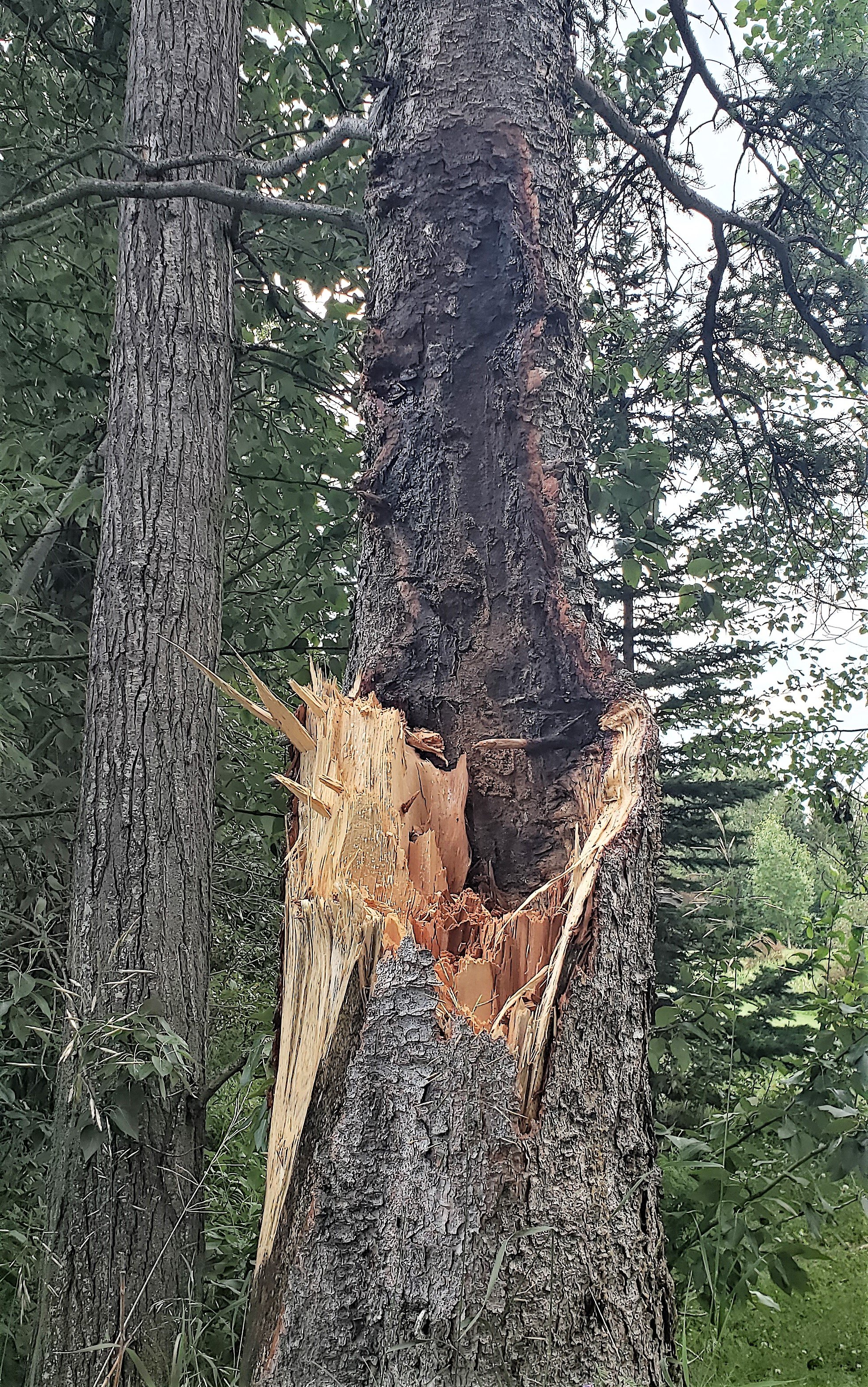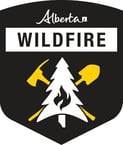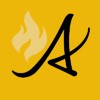Please ensure you fully extinguish your campfire. Soak it, stir it and soak it again until the ashes are cool to the touch. Never leave your campfire unattended.
If you see smoke or flame in the forest and suspect it's a wildfire, call 310-FIRE.

Humans and lightning are the two possible causes of wildfires in Alberta. This year, 40% of the wildfires in the Edson Forest Area were caused by lightning. (August 2023).
Bold indicates new or important information.
This update is best viewed on a web browser or the AB Wildfire Status App.
Previous Edson Forest Area Updates - Click here.
EDSON FOREST AREA WILDFIRE UPDATE
The wildfire danger in the Edson Forest Area is LOW. This means that fire can ignite but would have difficulty spreading to deeper vegetation layers or larger fuels, such as trees. Creeping ground fires would not travel very fast as the grass is green and there's sufficient moisture in the fine fuels. This is due to the the temperatures decreasing, the relative humidity increasing and the significant recent precipitation. You can view the provincial wildfire danger map and learn more about how to interpret fire danger by clicking here.
Since January 1, 2023, there have been 79 wildfires in the Edson Forest Area burning a total of 234,558 ha. The last reported wildfire was on August 11. There are currently six active wildfires, all are classified as under control. One is human-caused, four are caused by lightning and one remains under investigation.
Visit our website and click on the interactive map to view active wildfires, their locations and stats on the wildfire dashboard.
PROVINCIAL WILDFIRE UPDATE
Since January 1, 2023 in the Forest Protection Area, there have been 973 wildfires burning a total of 1,841,360 ha. Last year, there were 841 wildfires by this date with a total of 122,134 ha burnt. The 5 year average on this date is 922 wildfires with a total of 204,552 ha burned.
FULLY EXTINGUISH YOUR CAMPFIRE & NEVER LEAVE IT UNATTENDED
If you have a campfire, ensure you place it in an area away from vegetation and out of the wind. It's always best to have your campfire in a metal ring but if that's not possible, place it on bare minimal soil.
Be sure to never leave your campfire unattended and keep a sufficient amount of water nearby in case sparks land in nearby vegetation or your campfire escapes it's ring.
Before you leave, you must soak your campfire, stir the ashes and soak it again until it's cool to the touch. Campfires can burn into the ground and resurface at a later date which could cause a wildfire.
FARM AND ACREAGE | WILDFIRE PREVENTION
FIELDS AND PASTURELAND
This coming fall, reduce the risk of wildfire by reducing the accumulation of dry grass and stubble. This will help to prevent a fire from escaping your property or from coming in to your yard.
A really easy way to achieve this is by cutting the grass. Sounds simple, but well-maintained short grass can be a good fire deterrent. When a swift-moving grass fire hits a mowed patch of grass, it slows the spread of the fire and sometimes the fire will burn itself out.
Grain fields located near or next to building sites should be worked up. At the very least, work up a strip next to the building site to act as a fire guard. Dry stubble in the fields can carry a fire into the yard and with new farming practices of zero or minimal till, the accumulation of fine, dry fuel is increased. Make one or two passes around the yard before putting your tillage equipment away for the winter and you’ll go a long way in reducing the risk from wildfire.
If you have hay fields next to the yard, cut them as late in the season as possible to minimize re-growth, or mow a strip next to the building site to act as a fire guard. Allowing livestock to graze in the fields next to the yard in the fall will also help to reduce the amount of vegetation and potential fire hazard.
Dry pastureland presents the same challenges to wildfire as hayfields and grain fields. Tilling around the outside perimeter of pastureland will create a fire break that could save your field from burning, or prevent a fire from spreading to your other fields.
For more information, visit the Farm and Acreage Magazine online by clicking here.
BEFORE YOU BURN IT, GET YOUR FIRE PERMIT
Wildfire season in Alberta is from March 1 until October 31. During wildfire season, you are required to have a fire permit if you plan on burning in the Forest Protection Area, with the exception of a campfire. To request your free fire permit, contact the local forest area: (780) 723-8527 or you can request your permit using the new, convenient online fire permit portal. To view the video, click here.
PEMBINA WILDFIRE COMPLEX | EWF031, EWF039
EWF031 was detected on May 4, estimated to be 201,913 ha in size and determined to be caused by lightning.
EWF039 was detected on May 5, is 165 ha in size and determined to be human-caused.
DEEP CREEK COMPLEX | WCU001, WCU002, EWF035
WCU001 was detected on April 29, and estimated to be 6,284 ha in size.
WCU002 was detected on April 29 and estimated to be 2,478 ha in size.
EWF035 was detected on May 5 and is 19,672 ha in size.
WILDHAY WILDFIRE COMPLEX | EWF037, EWF040
EWF037 is estimated to be 12,073 ha and EWF040 is estimated to be 578 ha in size. They are both located south of the Little Smoky River, north of the Wild Hay River and east of Hwy 40 north.
These wildfires will continue to be monitored for activity and be actioned by local firefighting crews when needed. A reclamation plan has begun and equipment have started working on identified areas. This work is anticipated to continue into the winter months.
All of these wildfires are now classified as under control which means that firefighters have this fire fully contained and it is not expected to grow. None of these wildfires pose a threat to any communities or properties, including the Town of Edson. To learn more about wildfire classifications, click here. To view actual locations of the wildfires, visit the wildfire dashboard.
GENERAL INFORMATION ON WILDFIRES IN OUR AREA
WORK OR RECREATE NEAR WILDFIRE AREAS | We urge residents and members of the public to use extra caution near burnt areas. There are many hazards that may not be visible, like deep burning ash pits and falling trees. Burnt trees are a serious hazard, and trees that may look healthy with green needles or leaves could have burnt out roots under the ground and fall unexpectedly.
UNDERSTANDING WILDFIRE BEHAVIOUR | There are many factors that affect a wildfire and its growth, such as the wind, temperature and the forest fuel moisture conditions. You may have seen the Forestry fire danger signs that are posted around your communities, along highway 16, in Grande Cache on highway 40 and the Edson Forestry warehouse. We set the fire danger based on a number of factors, including the Fire Weather Index (FWI). The FWI is derived from data collected daily at various weather and includes observations of temperature, relative humidity, wind speed, and 24-hour precipitation. The FWI is a system used across Canada to quantify the fire hazard based on forest fuel moisture, temperature, relative humidity and forecasted winds.
Wildfires generally smoulder on and in the ground with very little open flame on low to moderate fire activity days. Creeping surface fire with open flame and the occasional torching tree is typical fire behaviour on moderate days. The days where the fire "picked up" and "took off" were on days when the fire danger was very high to extreme.
UNDERSTANDING WILDFIRE CLASSIFICATIONS | When firefighters classify a wildfire as OUT OF CONTROL, it means that the wildfire is burning and is expected to continue to grow within and possibly outside of its present boundary. The classification of BEING HELD means that under the current weather conditions and the resources available, there will be no unexpected growth, however firefighters anticipate the possibility of a small amount of spread which would be normal on a wildfire of this size. UNDER CONTROL means that the fire is fully contained, firefighters don't except any growth and the next stage would be extinguished. To learn more about wildfire classifications, click here.
Albertans are always asked to use caution when working or recreating in the outdoors:
- Before you burn it, get your fire permit. Fire permits in Alberta.
- Clear debris from hot spots on your off-highway vehicle.
- Ensure your campfire is out - soak it, stir it, soak it again.
- Before you head out this weekend, check out the albertafirebans.ca website or download the app to stay informed.
- For road closure information, please visit 511.alberta.ca
- For information regarding smoke in the area, you can visit firesmoke.ca
- NASA FIRMS Fire Information website is a great resource to give an idea of the location of wildfires in the area, but note that the data is based on interpolation and often can make the wildfire look larger then it actually is.
- To view the provincial wildfire danger map, click here.
.png?width=659&height=345&name=WF_Social-images%20(7).png)
ALBERTA WILDFIRE INFORMATION
- Subscribe to the Edson Forest Area wildfire update to receive an email when new information is posted.
- Download the Alberta Wildfire App for Apple and Android device.
- Join the conversation on Facebook, Twitter or Instagram.
For more information, please contact:



